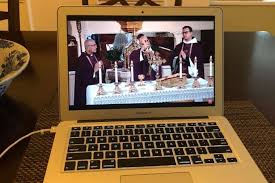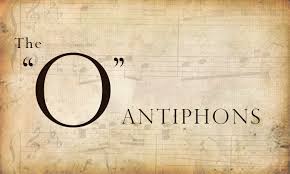I read recently a comparison between early Christians forced underground to Mass in the catacombs, and modern Catholics relegated to Mass on the Ethernet (Internet?). It made me wonder: There may be some similarity, but the analogy is quite a limited one, and in fact, like most analogies, they are more different than alike.
For some, watching Mass on a screen may be pious, uplifting, a relief, a substitute and a solace. But it is not ‘Mass’, nor what we might call ‘attending Mass’, for which, as the saying goes, one has to ‘be there’.
The sacraments – and especially the sacramentum sacramentorum of the Holy Eucharist – are incarnational, operating through our senses, through which God gives His grace. They are also relational, requiring a real, live interaction between the minister (usually a priest) and the recipient.
One definition of a sacrament, is an outward and visible sign of an inward and invisible grace, which cause what they signify.
In other words, they cause by signifying, and when they are made present to our senses, their graces and effects are also made present – the reality is there, regardless of the imperfection, even to a large extent the intentions, of the minister or the recipient.
The expression for this is ex opere operato – the sacraments work from ‘the very fact of their being performed’ (literally, ‘from the work having been worked’).
This is different for holy things or signs that are not sacraments, but rather sacramentals – the Rosary, scapular, holy water, blessings, images and icons, and the innumerable prayers in our tradition. The efficacy of these, in general, ex opere operantis, from the devotion of the one performing the action (literally, ‘from the work of the one working’).
Mass on a screen falls into the latter category than the former: It is more a sacramental than a sacrament. Of course, those present at that Mass are participating in a sacrament, and receive all the graces thereof.
In other words, virtual Masses are not a substitute for being present at Mass, and we should not get too comfortable with them, if we use them at all. For there is no obligation to do so, and one may substitute for the substitute, so to speak, some other ‘sacramental’, such as praying together through the Mass with a Missal and lectionary, sans screen, or praying privately or in a small group, perhaps at the same time as a nearby Mass (say, in your local parish). This may for some be more devotional than watching pixels on a monitor.
As a related aside: Similar thoughts came to mind years ago – well before Zoom and internet liturgies – at a World Youth Day Mass, where I was ‘relegated’ to well over a mile from the altar (which I could scarcely see, if at all), watching Mass on a monitor, which went blank part way through. A priest friend mentioned that such technical glitches are quite common in setting up streamed Masses. The WYD Masses were exceptional and rare (and perhaps with some relief, cancelled for the foreseeable future), and only streamed on jumbotrons for those actually present at the Mass. Now, such Masses can be beamed into the ‘cloud’, and who knows who’s watching, or not? How does one even know whether the Mass itself is live, or recorded? Does watching a Mass on EWTN from twenty years ago count?
Which brings us back to the catacombs and the internet, between which there are at least five differences that come to my own mind:
- Unlike the early Christians, who were resisting the directives of Nero and his successors, we Christians of the 21st century are doing just what the State wants us to do.
- Hence there is no danger, nothing contra mundum, to watching Mass on a screen. In fact, it is quite comfortable, and one can fall out of bed and turn on the computer. Or why not just stay in bed? Why get dressed at all? Why not just use the i-phone in the background propped against the espresso maker, as you whip up brunch?
- There is no real communal worship in a virtual Mass, and whoever is celebrating, or anyone else present, or anyone in the ‘virtual community’ has no idea you are even there. What of Sunday obligation and the need to gather together?
- While praying at such a Mass, in what direction does one pray and kneel? Does anyone else find it odd to genuflect before a screen? The words of Simon and Garfunkel come back to me (in shades of mediocrity – not theirs, but our own): And the people bowed and prayed, to a neon god they’d made. Of course, virtual Masses are not idolatry, and, as said, may help many, but I wonder where all this is headed. Are we being primed for something even less connected, or even contrary, to real Liturgy, or the permanent loss thereof?
- And, most of all, there is no Eucharist at a virtual Mass, no Holy Communion, present or received. There is no way to partake of the ‘Body and Blood of Jesus Christ,’ the very food of eternal life, through a screen.
The early Christians appreciated the Eucharist as a real, lived, personal, relational, incarnational, consumed and consuming Sacrament. They were determined that their right and their visceral need for the Mass was something for which they were willing to risk everything – even their very lives.
Are we?











